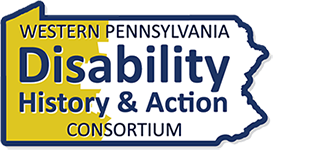Table of Contents
Scroll down to view the historic timeline or Jump to a section by clicking the links below:
1700s
- Late 1700s (National) Concurrent with the founding of the nation, near total neglect of people with disabilities. In late 1700s, estimated 80 percent of people in “poor houses” and prison have disabilities. Some services for disabled veterans begin.
1800s

- 1800s (National) Throughout the 1800’s, Americans learned about human difference and disability through “dime museums,” “freak shows,” “cabinets of curiosities.”
- Early 1800s (National) The 1800s brought the rise of “asylums,” facilities for the care of people, especially those with physical and mental disabilities. Children who were blind or deaf were the first to receive education. Around this time came the earliest “mainstreaming” of children who were blind or deaf, with the understanding that they could be integrated into society and did not need to be sent away to institutions.
- Late 1800s (National) The late 1800s also saw the popularization of the social philosophy called “eugenics,” which seeks to improve human hereditary traits through interventions. The goal was to create healthier, more intelligent people, save society’s resources, and lessen human suffering. Historically, eugenics has been used to justify human rights violations, such as forced sterilization of people with genetic defects. Nazi Germany is an example. From 1909 to 1935, California doctors used eugenics to justify sterilization of 295 patients in a California mental hospital. By 1933, 26 states had sterilization laws inspired by eugenics.

- 1817 (National) Thomas Hopkins Gallaudet founded the American Asylum for Education and Instruction of the Deaf, now known as the American School for the Deaf, in Hartford, Connecticut. Gallaudet University in Washington, D.C., is named in his honor.
- 1829 (National) The first school for blind children, New England Asylum for the Blind, opened in Massachusetts. It’s now called Perkins School for the Blind.
- 1832 (Western Pennsylvania) Pressley Ridge founded as Protestant Home for Children and the Pittsburgh Allegheny Home for the Friendless.
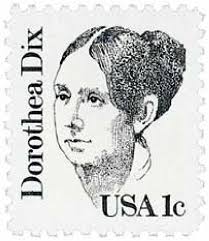 1849 (National) In 1849, reformer Dorothea Dix demanded government oversight of almshouses, where people with disabilities, criminals and others were thrown together. Dix wrote that she had found people with mental illness and retardation “in cages, in closets, cellars. Stalls, pens! Chained, naked, beaten with rods, and lashed into obedience.” As a result, state governments took over almshouses and built more, and set up specialized facilities for people with disabilities and others who populated the almshouses.
1849 (National) In 1849, reformer Dorothea Dix demanded government oversight of almshouses, where people with disabilities, criminals and others were thrown together. Dix wrote that she had found people with mental illness and retardation “in cages, in closets, cellars. Stalls, pens! Chained, naked, beaten with rods, and lashed into obedience.” As a result, state governments took over almshouses and built more, and set up specialized facilities for people with disabilities and others who populated the almshouses.
- 1854 (Western Pennsylvania) Allegheny County Home for the Poor opened in Collier Township. In 1939, Pennsylvania assumed operation of the facility as Woodville State Hospital for psychiatric patients. It closed in 1992.
- 1862 (Western Pennsylvania) Dixmont State Hospital (original name “Department of the Insane in the Western Pennsylvania Hospital of Pittsburgh) founded in Kilbuck Township. Closed in 1984.
- 1868-1899 (Western Pennsylvania) Pittsburgh Public Schools began special classes for Deaf children under Superintendent George Lackey.
- 1869 (National) In Boston, the first special classroom for children with disability in regular elementary school. The first students were Deaf. The classroom was later expanded to include students with other disabilities.
- 1877 (National) 1877 publication of The Jukes: A Study in Crime, Pauperism, Disease and Heredity, Richard Dugsdale. Claimed that mental retardation was the result of “bad blood.” Linked criminal tendencies to feeblemindedness and mental defect.”
- Late 1800s (National) By late 1800s, the term “asylum” was replaced by “hospital,” “school,” “institute.” By 1875, there were 25 state schools and institutes in the U.S. Although these “centers” may have begun with education in mind, most became custodial, segregated, isolated.
- 1880 (Western Pennsylvania) Warren State Hospital in Warren County opened for psychiatric patients.

1887 (Western Pennsylvania) Pittsburgh philanthropist Jane Holmes bequeathed $40,000 for the “care and education of the blind.” Western Pennsylvania Institute for the Blind opened in 1890 in temporary quarters in Lawrenceville before moving to its permanent Oakland location in 1894 on land donated by Mary Schenley.
- 1887 (Western Pennsylvania) In 1887, Pittsburgher Elizabeth Jane Cochran (1864-1922), an investigative reporter who used the pen name
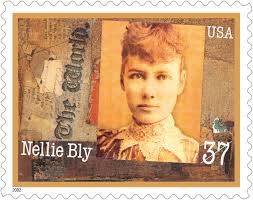 “Nellie Bly,” made her way into a New York asylum for “insane” women and girls, posing as a patient. She reported that the residents were treated like prisoners – locked in, deprived of blankets and warm clothing, and having buckets of cold water poured over their heads for “baths.” “A human rat-trap,” she wrote. “Easy to get in, but once there impossible to get out.” Her expose resulted in reforms in mental health care.
“Nellie Bly,” made her way into a New York asylum for “insane” women and girls, posing as a patient. She reported that the residents were treated like prisoners – locked in, deprived of blankets and warm clothing, and having buckets of cold water poured over their heads for “baths.” “A human rat-trap,” she wrote. “Easy to get in, but once there impossible to get out.” Her expose resulted in reforms in mental health care.
- 1893 (Western Pennsylvania) June 3 act of state legislature authorizes an “institute for the feeble-minded” in Western Pennsylvania. In 1897, Polk State School and Hospital opened in Venango County. It closed in 2023.
- 1893 (Western Pennsylvania) Mayview State Hospital, a psychiatric hospital founded as Marshalsea Poor Farm, opens in South Fayette Township in Allegheny County. It closed in 2008.
1900-1949
- 1902 (Western Pennsylvania) Memorial Home for Crippled Children (now known as The Children’s Institute) founded by Mary Irwin Laughlin.
- 1905 (Pennsylvania) Pennsylvania legislature passed law entitled,” An Act for the Prevention of Idiocy.” Governor Samuel Pennypacker vetoed the bill.He wrote: “Scientists, like all other men whose experiences have been limited to one pursuit…sometimes need to be restrained. Men of high scientific attainment are prone …to lose sight of broad principles outside their domain….To permit such an operation would be to inflict cruelty upon a helpless class…which the state has undertaken to protect.”
- 1917 (Western Pennsylvania) D.T. Watson Home for Crippled Children (now Watson Institute) founded in Sewickley with endowment from David Thompson Watson and his spouse Margaret Walker Watson.
- 1918 to 1920 (National) First federally-funded rehabilitation programs are a response to increase in number of people with disabilities, especially war veterans and victims of industrial accidents.
- 1919 (Western Pennsylvania) Easter Seals Society of Western and Central PA founded by Edgar Allen as a chapter of National Society for Crippled Children, the first national organization of its kind.
- 1919 (Western Pennsylvania) Torrence State Hospital in Westmoreland County opened for psychiatric patients.
- 1930s to 1940s (National) Growth of social programs and rehabilitation for war veterans. Franklin D. Roosevelt is first U.S. president with a visible disability. Yet he had an agreement with the press not to disclose his paralysis from polio.

- 1937 (Western Pennsylvania) 107 blind employees organized a strike in a Pittsburgh broom-making “sheltered” workshop. Workers demanded decent wages and more healthful working conditions.
- 1940s to 1950s (National) Throughout the 1940s and 1950s, parents who did not want their children institutionalized or banned from public schools sought each other and started to organize and advocate for laws that provided substantive education, rehabilitation, and civil rights. They questioned the statement,” Nothing can be done for your child.” By 1950, 19 states had parent groups concerned with improving the lives of children and adults with intellectual disability. Many of these groups evolved into the national “Association for Retarded Citizens,” now simply known as “The Arc.”
- 1949 (Western Pennsylvania) The Arc of Pennsylvania founded.
1950s
- 1951 (Western Pennsylvania) United Cerebral Palsy of Pittsburgh (now Community Living and Support Services – CLASS) and Arc Allegheny (now ACHIEVA) founded.
1952 (Western Pennsylvania) Dr. Gertrude Barber founded Erie’s Barber National Institute to educate children with developmental disabilities.
- 1954 (National) Brown vs. Board of Education (1954) and the black civil rights movement set the stage for disability rights advocacy.
- 1955 (Pennsylvania) Arc of Pennsylvania and state officials discover severe overcrowding and long waiting lists in state institutions. Legislation passed to establish state-supported interim care facilities.
- 1956 (Across Pennsylvania) Pennsylvania Act 429 mandates provision of special education for children with intellectual disability in public schools.
- 1957 (Western Pennsylvania) Ebensburg State School and Hospital opened in Cambria County.
1960s
- 1960s (National) Beginning in the 1960s, advocacy efforts to expose inhumane conditions in institutions paralleled families’ desire for their children with disabilities to live at home, access appropriate education, and achieve meaningful adult lives.
- 1960 (National) Federal legislation supporting “Independent Living” initiatives began in 1960.
- 1962 (Western Pennsylvania) Western State School and Hospital for “the mentally retarded” opens in Canonsburg. The institution closed in 2000.
- 1963 (Western Pennsylvania) Disability rights advocates establish Magic Carpet Transportation Service, Pittsburgh’s first nonprofit paratransit service for people with disabilities.
- 1963 (Western Pennsylvania) The School at McGuire Memorial, a ministry of the Felician Sisters of North America, founded to serve children and adults with physical and developmental disabilities.
- 1964 (National) Civil Rights Act (1964) prohibits discrimination based on race, color, national origin.
- 1965 (National) 1965 publication of Christmas in Purgatory, an expose’ of institutional conditions by Burton Blatt, a Syracuse University professor, and Fred Kaplan, a photographer.
- 1965 (Western Pennsylvania) Wesley Spectrum (originally The Village Academy of the Christy United Methodist Church of Bethel Park) offers education and programs to students with autism and other developmental disabilities.
- 1966 (Western Pennsylvania) Pennsylvania Mental Health/Mental Retardation Act allocates funds for community living and services, and sets the stage for the end of institutionalization.
- 1966 (National) Federal Bureau for the Handicapped established in 1966.
- 1967 (Western Pennsylvania) PACE School founded by a small group of professionals in a McKeesport church.
 1968 (National) International symbol of access introduced in 1968.
1968 (National) International symbol of access introduced in 1968.
- 1968 (Western PA and Across Pennsylvania) Arc of Pennsylvania initiates visits to all state-run institutions to report on condition. Arc of Allegheny County (now Achieva) participates in the effort to expose inhumane conditions and fight for closure.
1970s
- Early 1970s (Across Pennsylvania) Mel Knowlon recruited from Nebraska to develop community homes for people with intellectual disabilities in Pennsylvania.
- 1972 (Pennsylvania) PA Association for Retarded Citizens (PARC) vs. Commonwealth of Pennsylvania pursued the right to education for students with intellectual disability. The PARC Consent Decree laid the foundation for federal Public Law 94-142, Education for All Handicapped Children Act of 1975 — later named “Individuals with Disabilities Education Act” (IDEA).
- 1972 (Western Pennsylvania) Association for Children and Adults with Learning Disabilities (ACLD) Tillotson School founded in Pittsburgh’s South Hills.
- 1972 (National) Publication of The Principle of Normalization in Human Services by Syracuse University professor Wolf Wolfensberger, an influential book that led to change from institutional model to community living services.
- 1972 (Western Pennsylvania) First community homes (also called “group homes”) developed in Pennsylvania.
- 1973 (National) Section 504 of the Rehabilitation Act of 1973 makes it illegal for federal agencies, public universities, and other public institutions receiving any federal funds to discriminate on the basis of disability.
- 1975 (Pennsylvania) Pennsylvania outlaws “peonage” in state institutions. Peonage refers to forcing institutionalized people to perform work without pay.
- 1977 (Pennsylvania) U.S. District Court rules that conditions at Pennhurst State School and Hospital near Philadelphia violated the civil rights of residents. Commonwealth ordered to replace Pennhurst with appropriate programs in the community.
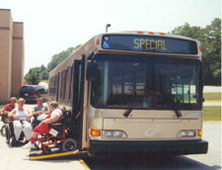
- 1978 (Western Pennsylvania) The Port Authority of Allegheny County establishes the Committee for Accessible Transportation to assist with the planning and implementing of a paratransit service for people with disabilities. The collaborative between the disability community, Port Authority, private transportation providers, Carnegie Mellon and others resulted in a unique system design, still considered a national model. Launched in 1979, ACCESS is one of the most successful shared ride services in the nation. In 1991, Port Authority of Allegheny County obtained the first wheelchair accessible buses. In 2003, the Port Authority’s bus fleet became 100% wheelchair accessible. In 2014, ACCESS provided 593,000 trips for people with disabilities out of total ACCESS ridership of 1.6 million.
- 1978 (Western Pennsylvania) Mayor Richard Caligiuri forms the Committee on Architectural Barriers following the passage of the federal Architectural Barriers Act of 1978, which mandated that that all buildings designed, constructed, altered or leased with federal funds be made accessible. Installing curb cuts in Downtown Pittsburgh was one of the committee’s first projects.
1980s
- Early 1980s (Western Pennsylvania) Pittsburgh Committee for Accessible Housing formed.
- 1984 (National) The federal Voting Accessibility for the Elderly and Handicapped Act passed. It mandates that polling places remove physical barriers to accessibility. Currently, all of Allegheny County’s 1321 polling locations have accessible entries, compared with 248 inaccessible polling places in 2005.
- 1988 (National) 1988 amendments to the federal Fair Housing Amendments Act require that a certain number of accessible housing units be created in all new multi-family housing. The act covers all buildings, not only those in receipt of federal funding.
1990s
- 1990 (National) Americans with Disabilities Act (1990) signed into law.
- 1993 (Western Pennsylvania) U.S. District Court approves settlement on behalf of residents at Western Center in Canonsburg, PA. Commonwealth ordered to evaluate residents to determine appropriateness for community living.
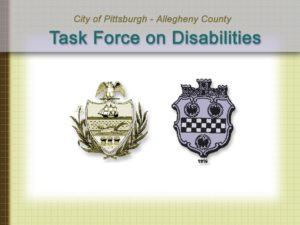
- 1994 (Western Pennsylvania) Founding of the City of Pittsburgh-Allegheny County Task Force on Disabilities, a 13-member body that advises the City and County on issues that improve the quality of life for people with disabilities.
- 1996 (National) The federal Telecommunications Act (1996) requires that computers, telephones, closed captioning, and other telecommunication devices and equipment be made accessible.
- 1997 (Western Pennsylvania) Three Rivers Center for Independent Living files a lawsuit against City for failure to comply with the ADA by not installing curb cuts on newly repaved streets. The lawsuit was settled in 1999, with the City agreeing to a three-year timeframe for installing curb cuts that should have been done since 1992.
- 1997 (Western Pennsylvania) Western Pennsylvania disability rights advocates join a nationwide demonstration protesting lack of wheelchair access on Greyhound buses.
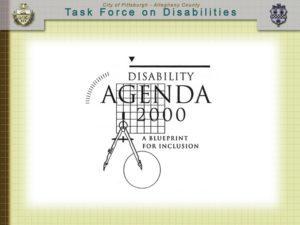
- 1998 (Western Pennsylvania) City of Pittsburgh and Allegheny County launch Disability Agenda 2000 process to recommend policies that will bring about the highest quality of life, equal opportunity and effective participation in community life for people with disabilities.
- 1999 (National) U.S. Supreme Court issues Olmstead Decision in 1999, banning unnecessary segregation of people with intellectual disabilities.
2000-2009
- 2000 (national) Developmental Disabilities Assistance and Bill of Rights Act assures that individuals with disabilities and their families participate in the design of have access to needed community services, individualized supports, and other forms of assistance that promote self-determination, independence, productivity, and inclusion.
- 2001 (Western Pennsylvania) Allegheny County establishes Mental Health Court, which addresses issues related to people with mental health disabilities by placement in mental health services rather than incarceration when faced with non-violent criminal charges.
- 2001 (Western Pennsylvania) Opening of Pittsburgh’s PNC Park, widely recognized as the most accessible Major League facility in the nation. Pittsburgh disability community also provided guidance on accessibility planning for Heinz Field (now Acrisure Stadium), opened in 2001, and Consol Energy Center (now PPG Paints Arena), opened in 2010.
- 2002 (Western Pennsylvania) Efforts begin to increase access at the Three Rivers Arts Festival, such as wheelchairs on loan, improved signage, maps of accessible parking lots, interpreters at performances and accessible portable toilets.
- 2002 (Pennsylvania) Pennsylvania State legislature passes the Visitability Tax Credit Program, which provides tax incentives for new residential construction or renovation projects that incorporate accessibility features.
- 2002 (National) The federal Help America Vote Act requires that at least one voting machine at designated polling locations be accessible to people with disabilities.
- 2002 (Western Pennsylvania) The Healthcare Council of Western Pennsylvania and its partners design and implement “Every Contact Counts,” the first local program to educate hospital employees about the support needs of people with disabilities. Trainings presented in 10 hospitals.
- 2004 (Western Pennsylvania) Urban League, Community College of Allegheny County, Three Rivers Center for Independent Living, and the City of Pittsburgh are the first to sign pledges to employ people with disabilities.
- 2005 (Western Pennsylvania) Allegheny County establishes Disability Connection office to coordinate efforts to improve services to all people with disabilities and elevate issues of quality of life, equal opportunity and effective participation in the community.
- 2005 (Western Pennsylvania and Across Pennsylvania) The Parent Education & Advocacy Leadership Center (PEAL Center) to support and educate other parents of children with disabilities and special health care needs, and professionals who work in these fields. In 2014, PEAL Center was designated by the U.S. Department of Education as a Parent Training and Information Center for the entire state of Pennsylvania.
- 2007 (Western Pennsylvania) UPMC establishes the Disabilities Resource Center to ensure system-wide staff training and facility accessibility.
- 2008 (Western Pennsylvania) University of Pittsburgh School of Dental Medicine opens Center for Patients with Special Needs.
 2008 (Western Pennsylvania) In conjunction with the 250th anniversary of the City of Pittsburgh, Allegheny County Disability Connection office produces “Voices of Our Region,” a multimedia project documenting the history of local people with disabilities.
2008 (Western Pennsylvania) In conjunction with the 250th anniversary of the City of Pittsburgh, Allegheny County Disability Connection office produces “Voices of Our Region,” a multimedia project documenting the history of local people with disabilities.
- 2008 (National) The ADA Amendments Act of 2008 (ADAAA) broadens the ADA, reversing certain Supreme Court decisions that limited the rights of persons with disabilities.
- 2009 (Pennsylvania) Disability Rights Network of Pennsylvania files class action lawsuit against Commonwealth of Pennsylvania on behalf of more than 1200 residents of five state-run institutions who had not been offered the opportunity to move into community living arrangements.
2010-2019
- 2010 (National) The federal 21st Century Communications and Video Accessibility Act includes protections that enable people with disabilities to access broadband, digital and mobile innovations.
- 2010 (National) In 2010, federal law changes the term “mental retardation to “intellectual disability.” Before this, some changes in language to describe disability included:
- The term “cripple” used from late 18th century to 1970s.
- The term “defective” used from late 1700s to 1930s.
- The term “dumb” (meaning unable to speak) used from early 1800s until 1970s.
- The term “idiot” was coined by psychologists in the late 19th century.
- The term “moron” was coined by psychologists in 1910.

- 2010 (Western Pennsylvania) Pittsburgh Cultural Trust and Greater Pittsburgh Arts Council begin efforts to improve accessibility and inclusion of individuals with disabilities in Pittsburgh’s arts and cultural community.
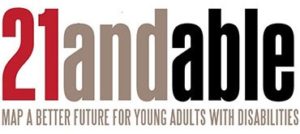
- 2010 (Western Pennsylvania) “21 and Able” project, launched by United Way of Southwestern Pennsylvania to advocate for needs of young people with disabilities as they transition to adulthood. The #IWantToWork campaign and other initiatives boost numbers of young adults with disabilities in local workforce. Two conferences – “From Wrongs to Rights” (2013) and “From Rights to Action”(2014) – convene young self-advocates to learn about disability rights history and their role as new generation of advocates. As of 2021, the initiative is housed at the Parent Education and Advocacy Leadership (PEAL) Center.
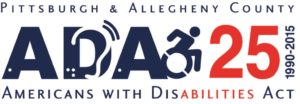 2015 (Western Pennsylvania) Pittsburgh and Allegheny County’s year-long celebration of 25th anniversary of the Americans with Disabilities Act.
2015 (Western Pennsylvania) Pittsburgh and Allegheny County’s year-long celebration of 25th anniversary of the Americans with Disabilities Act.
- 2015 (Western Pennsylvania) National Council on Disability holds quarterly meeting at University of Pittsburgh and honors former Pennsylvania Governor and U.S. Attorney General Dick Thornburgh for his efforts to enact the Americans with Disabilities Act, celebrating its 25th anniversary in 2015.
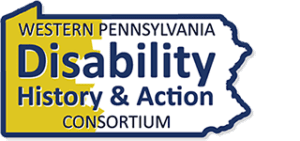 2015 (Western Pennsylvania) Western Pennsylvania Disability History and Action Consortium founded to preserve and honor the historic struggle of people with disabilities to attain human and civil rights and to share the lived experiences of today, in order to promote community access, participation and equal opportunity.
2015 (Western Pennsylvania) Western Pennsylvania Disability History and Action Consortium founded to preserve and honor the historic struggle of people with disabilities to attain human and civil rights and to share the lived experiences of today, in order to promote community access, participation and equal opportunity.
- 2016 (Across Pennsylvania) #IWantToWork United Way of Southwest PA initiative successfully campaigns for Pennsylvania’s Work Experience For High School Students with Disabilities (Act 26) which ensures services with the Office of Vocational Rehabilitation and transparent county data on transition to competitive, integrated employment for students with disabilities.
- 2016 (Across Pennsylvania) Pennsylvania Governor Tom Wolf signs “Employment First” executive order, requiring competitive-integrated employment to be the first consideration and preferred outcome of all publicly funded education, employment and training, and long-term supports and service programs for working-age Pennsylvanians with a disability.
- 2016 (National) Uber settles a lawsuit filed by the National Federation of the Blind to assure that passengers with guide dogs received equal access to transportation.
- 2017 (National) The U.S. Equal Employment Opportunity Commission issues a final rule on Section 501 of the Rehabilitation Act of 1973 that updates the responsibilities of federal agencies to take proactive steps to employ qualified individuals with disabilities and set representation goals of 12% for individuals with disabilities and 2% for individuals with specific, targeted disabilities. The updates also require the provision of personal assistance services to employees who need them because of a disability.
- 2018 (National) The U.S. Department of Transportation requires airlines to track the number of reports they receive of mishandled wheelchairs and scooters.
- 2018 (National) The 21st Century Integrated Digital Experience Act (IDEA) requires federal agencies to modernize their websites and digital services to accessibility for people with disabilities. IDEA also requires federal chief information officers to coordinate with other executives and ensure adequate funding and resources to execute its requirements.
- 2019 (National) The United States becomes the fiftieth member of the Marrakesh Treaty to Facilitate Access to Published Works for Persons Who Are Blind, Visually Impaired or Otherwise Print Disabled. The original treaty on copyright was adopted in Marrakesh, Morocco, in 2013.
2020-present day
- 2020 (Western Pennsylvania) FISA Foundation, Heinz Endowments, and other local foundations launch “Disability Inclusion & Access: Moving Forward” to encourage nonprofits, foundations and community organizations to be more welcoming and inclusive of people with disabilities.
- 2020 (National) U.S. Supreme Court rules in Kahler v. Kansas that the Fifth and Fourteenth Amendments of the U.S. Constitution do not require states to adopt the insanity defense in criminal cases based on the defendant’s ability to recognize right from wrong.
- 2021 (National) U.S. Department of Education cancels student debt for over 40,000 Americans who were granted loan forgiveness because of disabilities but later had their debt reinstated after they did not submit certain paperwork.
- 2022 (Western Pennsylvania) 1st Annual Disability Pride Pittsburgh event promotes visibility, representation and advocacy for an inclusive community.
- 2022 (Across Pennsylvania) Pennsylvania Department of Education launches the “Disability Inclusive Curriculum Pilot Program” to teach K-12 students about the social, political, and historical contributions of people with disabilities and to promote inclusivity and understanding among learners.
- 2022 (National) U.S. Department of Transportation publishes “Airline Passengers with Disabilities Bill of Rights,” which the fundamental rights of air travelers with disabilities under the Air Carrier Access Act and its implementing regulation, 14 Code of Federal Regulations (CFR) Part 382.
Sources:
- Arc of Pennsylvania
- American History Museum, Smithsonian Institution
- Asylum Projects
- Center for Human Policy, Syracuse University
- Disability History Museum
- Joseph Shapiro, No Pity, Times Books, 1993
- Three Rivers Community Fund
- Wikipedia
